When farmland is converted from grain production to grasslands, the greatest environmental benefits are obtained by choosing land that is close to existing natural areas or has high nutritional loads to aquatic environments, a new study indicates.
Conversion from cereals to grasslands is good for the environment – but where in the landscape is the best place to carry it out? According to researchers from the Department of Agroecology at Aarhus University, it depends on whether you prioritise improvement of nature and the aquatic environment, how much biomass you can produce, or how much land is needed to so do – or a combination. The researchers developed a method that enabled them to optimise selection of the best areas, where multiple benefits were taken into consideration.
Almost two thirds (63 per cent) of Denmark’s land area is taken up with intensive agriculture. Farming challenges the environment, climate, and water. The impact of agriculture can be reduced if some of the agricultural land is converted from cultivation of cereals to cultivation of grass for green biorefining.
Read more at Aarhus University
Photo credit: Free-Photos via Pixabay


